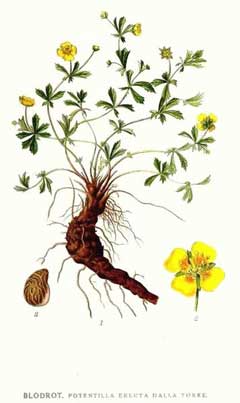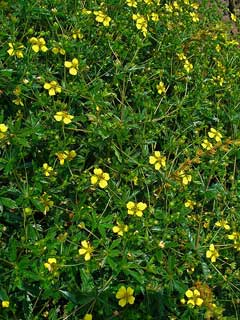 |
|
http://commons.wikimedia.org/wiki/File:300_Potentilla_erecta.jpg |
 |
| http://commons.wikimedia.org/wiki/User:Llez |
Translate this page:
Summary
Physical Characteristics

 Potentilla erecta is a PERENNIAL growing to 0.3 m (1ft) by 0.2 m (0ft 8in).
Potentilla erecta is a PERENNIAL growing to 0.3 m (1ft) by 0.2 m (0ft 8in).
See above for USDA hardiness. It is hardy to UK zone 5 and is not frost tender. It is in flower from June to September. The species is hermaphrodite (has both male and female organs) and is pollinated by Bees, flies, beetles, Lepidoptera (Moths & Butterflies). The plant is self-fertile.
Suitable for: light (sandy), medium (loamy) and heavy (clay) soils and prefers well-drained soil. Suitable pH: mildly acid, neutral and basic (mildly alkaline) soils. It can grow in semi-shade (light woodland) or no shade. It prefers moist soil.
UK Hardiness Map
US Hardiness Map
Synonyms
Tormentilla erecta L.
Plant Habitats
Meadow; Hedgerow;
Edible Uses
Edible Parts: Root
Edible Uses: Tea
The roots are extremely rich in tannin, long boiling converts this into a gum and it can then be eaten [115]. An emergency food, it is only eaten when all else fails[177]. A tea is made from the rhizomes[183].
References More on Edible Uses
Medicinal Uses
Plants For A Future can not take any responsibility for any adverse effects from the use of plants. Always seek advice from a professional before using a plant medicinally.
Antibiotic Antidiarrhoeal Astringent Dysentery Enuresis Haemostatic Hypoglycaemic Odontalgic
Containing more tannin than oak bark, all parts of tormentil are strongly astringent, finding use wherever that action is required. This plant is considered to be one of the safest native astringents and it is widely used in herbal medicine in the treatment of diarrhoea, dysentery, sore throats etc[4, 238, 254]. The whole plant, and especially the root, is antibiotic, strongly astringent, haemostatic and hypoglycaemic[4, 7, 9, 21, 165]. It is used in the treatment of diarrhoea, dysentery, irritable bowel syndrome, colitis, ulcerative colitis etc[254]. Externally, the plant makes a good styptic for cuts etc., and a strongly made decoction has been recommended as a wash for mouth ulcers, infected gums, piles and inflamed eyes[4, 254]. Extracts are used to treat chapping of the anus and cracked nipples[7]. The plant's effectiveness as a toothache remedy is undeniable and it has also been of benefit in treating bed-wetting by children[7].
References More on Medicinal Uses
The Bookshop: Edible Plant Books
Our Latest books on Perennial Plants For Food Forests and Permaculture Gardens in paperback or digital formats.

Edible Tropical Plants
Food Forest Plants for Hotter Conditions: 250+ Plants For Tropical Food Forests & Permaculture Gardens.
More

Edible Temperate Plants
Plants for Your Food Forest: 500 Plants for Temperate Food Forests & Permaculture Gardens.
More

More Books
PFAF have eight books available in paperback and digital formats. Browse the shop for more information.
Shop Now
Other Uses
Cosmetic Dye Tannin
A red dye is obtained from the roots[4, 66, 115]. The plant, and especially the root, is rich in tannin[4, 7]. It s used cosmetically as a compress to tone up flabby skin[7]. The root contains up to 20% tannin[238].
Special Uses
References More on Other Uses
Cultivation details
Easily grown in a well-drained loam, preferring a position in full sun but tolerating shade[1]. Prefers a light acid soil, disliking heavy and strongly calcareous soils[17]. Members of this genus are rarely if ever troubled by browsing deer[233].
References Carbon Farming Information and Carbon Sequestration Information
Temperature Converter
Type a value in the Celsius field to convert the value to Fahrenheit:
Fahrenheit:
The PFAF Bookshop
Plants For A Future have a number of books available in paperback and digital form. Book titles include Edible Plants, Edible Perennials, Edible Trees,Edible Shrubs, Woodland Gardening, and Temperate Food Forest Plants. Our new book is Food Forest Plants For Hotter Conditions (Tropical and Sub-Tropical).
Shop Now
Plant Propagation
Seed - sow early spring or autumn in a cold frame. When they are large enough to handle, prick the seedlings out into individual pots and grow them on in the greenhouse for their first winter. Plant them out into their permanent positions in late spring or early summer, after the last expected frosts. Division in spring. Larger divisions can be planted out direct into their permanent positions. We have found that it is better to pot up the smaller divisions and grow them on in light shade in a cold frame until they are well established before planting them out in late spring or early summer.
Other Names
If available other names are mentioned here
Native Range
TEMPERATE ASIA: Turkey, Russian Federation-Ciscaucasia (Ciscaucasia), Azerbaijan, Georgia, Russian Federation (Dagestan), Russian Federation (Altay, Kurganskaja oblast, Novosibirsk, Omsk, Tomsk, Tyumen (south)) EUROPE: Denmark, Finland, United Kingdom, Ireland, Iceland, Norway, Sweden, Austria, Belgium, Switzerland, Czech Republic, Germany, Hungary, Netherlands, Poland, Slovakia, Russian Federation-European part (European part (incl. arctic region)), Belarus, Estonia, Lithuania, Latvia, Moldova, Ukraine, Albania, Bulgaria, Bosnia and Herzegovina, Greece, Croatia, Italy, North Macedonia, Romania, Serbia, Slovenia, Spain, France (incl. Corsica), Portugal AFRICA: Portugal (Azores)
Weed Potential
Right plant wrong place. We are currently updating this section.
Please note that a plant may be invasive in one area but may not in your area so it's worth checking.
Conservation Status
IUCN Red List of Threatened Plants Status :

| Related Plants
|
| Latin Name | Common Name | Habit | Height | Hardiness | Growth | Soil | Shade | Moisture | Edible | Medicinal | Other |
| Potentilla anserina | Silverweed | Perennial | 0.3 |
4-8
| F | LMH | SN | M | 3 | 3 | 2 |
| Potentilla bicolor | | Perennial | 1.0 |
5-9
| | LMH | SN | M | 1 | 0 | |
| Potentilla chinensis | Chinese Cinquefoil | Perennial | 0.6 |
-
| | LMH | SN | M | 1 | 1 | |
| Potentilla cryptotaeniae | | Perennial | 1.0 |
-
| | LMH | SN | M | 0 | 1 | |
| Potentilla discolor | | Perennial | 0.3 |
-
| | LMH | SN | M | 2 | 1 | |
| Potentilla egedei | Pacific Silverweed | Perennial | 0.5 |
4-8
| | LMH | SN | M | 2 | 1 | |
| Potentilla fragarioides | | Perennial | 0.3 |
-
| | LMH | SN | M | 1 | 1 | |
| Potentilla fruticosa | Shrubby Cinquefoil, Potentilla | Shrub | 1.2 |
2-6
| M | LMH | SN | M | 1 | 1 | 3 |
| Potentilla glandulosa | Gland Cinquefoil, Sticky cinquefoil, Arizona cinquefoil, Ashland cinquefoil, Ewan's cinquefoil, Hans | Perennial | 0.6 |
6-9
| | LMH | SN | M | 1 | 1 | |
| Potentilla hippiana | Woolly Cinquefoil | Perennial | 0.6 |
5-9
| | LMH | SN | M | 0 | 1 | |
| Potentilla kleiniana | | Perennial | 0.3 |
-
| | LMH | SN | M | 1 | 1 | |
| Potentilla multifida | | Perennial | 0.3 |
3-7
| | LMH | SN | M | 2 | 0 | |
| Potentilla nepalensis | Nepal Cinquefoil, Cinquefoil | Perennial | 0.6 |
5-10
| M | LMH | SN | M | 2 | 1 | |
| Potentilla norvegica | Norwegian Cinquefoil | Annual/Perennial | 0.3 |
3-7
| | LMH | SN | M | 0 | 1 | |
| Potentilla palustris | Marsh Cinquefoil | Perennial | 0.5 |
3-7
| | LMH | SN | We | 1 | 1 | 1 |
| Potentilla recta | Rough-Fruited Cinquefoil, Erect cinquefoil | Perennial | 0.6 |
4-8
| | LMH | SN | M | 2 | 1 | 0 |
| Potentilla reptans | Cinquefoil, Creeping cinquefoil | Perennial | 1.0 |
4-8
| | LMH | N | DM | 1 | 2 | 2 |
| Potentilla rupestris | Rock Cinquefoil | Perennial | 0.5 |
4-8
| | LMH | SN | DM | 1 | 0 | |
| Potentilla simplex | Old Field Cinquefoil, Common cinquefoil | Perennial | 0.1 |
3-7
| | LMH | SN | M | 0 | 1 | 0 |
| Potentilla supina | | Annual/Perennial | 0.3 |
-
| | LMH | SN | M | 1 | 1 | |
|
Growth: S = slow M = medium F = fast. Soil: L = light (sandy) M = medium H = heavy (clay). pH: A = acid N = neutral B = basic (alkaline). Shade: F = full shade S = semi-shade N = no shade. Moisture: D = dry M = Moist We = wet Wa = water.
Now available:
Food Forest Plants for Mediterranean Conditions
350+ Perennial Plants For Mediterranean and Drier Food Forests and Permaculture Gardens.
[Paperback and eBook]
This is the third in Plants For A Future's series of plant guides for food forests tailored to
specific climate zones. Following volumes on temperate and tropical ecosystems, this book focuses
on species suited to Mediterranean conditions—regions with hot, dry summers and cool, wet winters,
often facing the added challenge of climate change.
Read More
Expert comment
Author
(L.)Raeusch.
Botanical References
17200
Links / References
For a list of references used on this page please go here
Readers comment